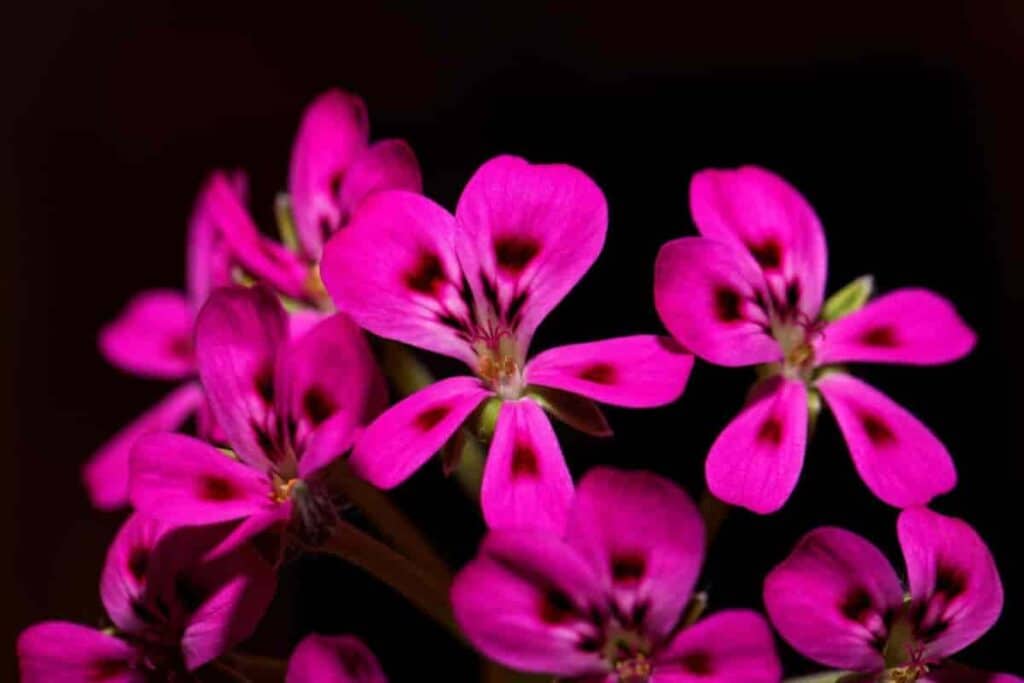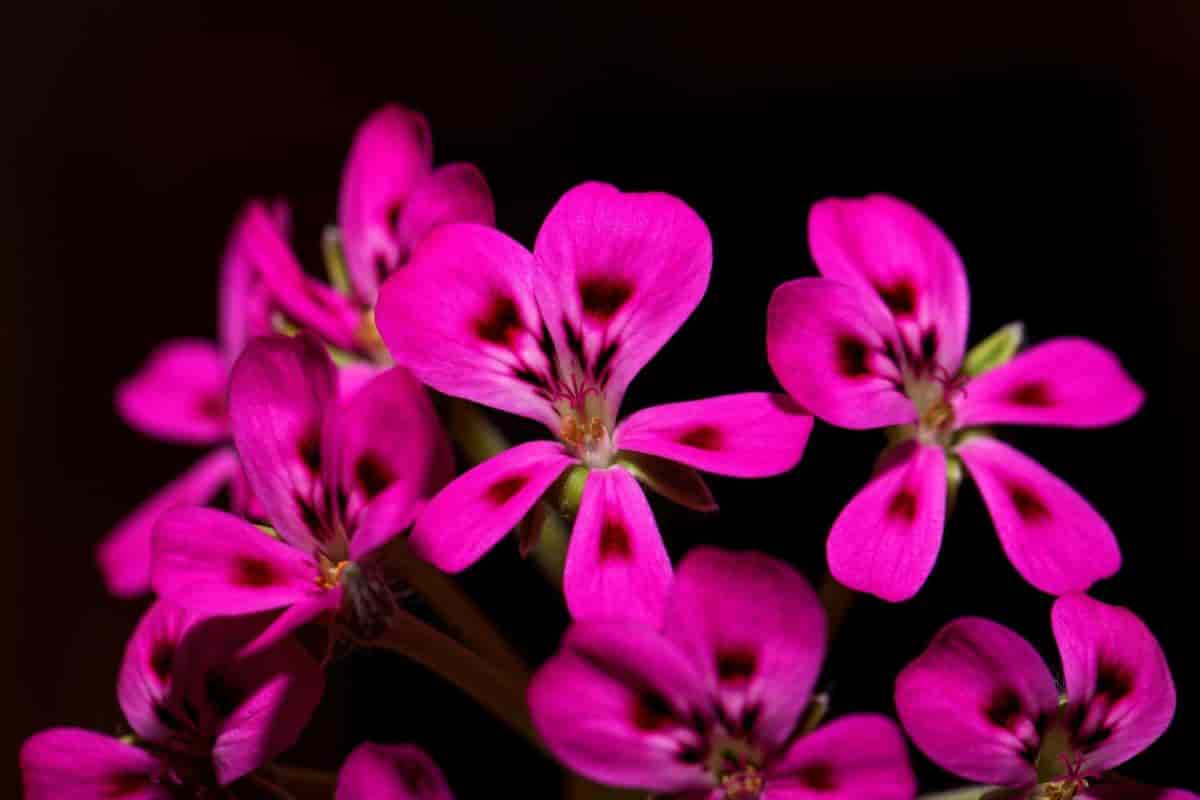A fascinating group of plants is the so-called cactus geraniums. It has been my hobby for many years to collect these peculiar-looking plants.

Pelargonium Echinatum
Perhaps the best known in this group is Pelargonium echinatum, sometimes called the prickly stalked cranesbill or sweetheart geranium.
The stalk is smooth, set with many spines which bend back and form the stipulate, becoming fleshy and rigid, hence the name echinatum.
The beautifully rounded leaves, soft and downy, especially on the underside, are light gray-green. They begin to grow early in the Fall months and will entirely cover the spiny stalks in less than three months.
The flowering stem grows from the top of the stalk a foot or more in height, and as it matures, it throws out branches or peduncles, about five in number, each having a leaf at the base. The umbels have seven or eight single flowers.
The three lower petals are white, and the two upper have rich purple markings that resemble a tiny heart, hence the pretty name of sweetheart geranium. This species flowers for us during the winter and is best during February.
The flowers are long-lasting and beautiful, changing from white to blush pink as they fade.
Water In Moderation
The plants become dormant in late Spring and should be watered sparingly, keeping the topsoil very slightly moist. They can be set aside in partial shade and left in the pots until early Fall.
It is best to shake off old soil from the roots and repot in a mixture of equal parts of good garden loam, sand anti-peat moss, or well-decayed cow manure.
If you can secure lime rubble, a handful well crushed, added to the potting soil will benefit the plant, for the cactus geraniums require an alkaline soil to be happy.
Repot plants as often as necessary, never allowing them to become pot-bound during the growing season. Full sun with a warm temperature is best for echinatum.
Cactus Geraniums
Cactus geraniums can be propagated from cuttings taken when the plant begins to grow. Although I have successfully rooted this species when dormant, it takes much longer for the roots to form.
Place the cuttings in sand and water well, allowing the sand to dry before giving more water. Echinatum may also be propagated from the small tubers formed on the roots.
If the tubers are removed and exposed to the air for a few hours or overnight, they will make a better start.
Care should be taken not to plant too deeply but just below the surface of the soil. Plants do not usually flower the first year when grown from tubers.
The lavender flowered form, Pelargonium stapeltoni, is also very interesting. It is a hybrid of echinatum and was produced in England in 1842.
The leaves are rounded and so thickly set with white hairs that they give the effect of iridescent silver.
Pelargonium Species
Pelargonium Fulgidum
Pelargonium fulgidum is a bright, red flowering species, the parent of wide tuberous rooted varieties. Introduced into England in 1821 from South Africa, it may be grown from seed, for we have found it listed in catalogs from that country.
It is not strictly a “cactus” type, for it lacks the spines but does have the same woody stem. In the old books, this is called the “celandine-leaved storksbill,” and indeed, the foliage resembles our wild celandine, with a softer, silkier sheen and the same strange odor.
It is easily propagated from cuttings taken from the new wood, which is less woody than echinatum and, therefore, roots more readily.
Pelargonium Gibbosum
One of the most unpredictable plants in this group is the “knotted storksbill’’, Pelargonium gibbosum. A tall growing species that could be classed as a climber, it attains a height of 5′ or 6′ feet.
It requires only a short resting period of a month or less when the dead-looking sticks will start new leaves.
The foliage is a beautiful gray-green and very smooth. Flowers are light yellow and delightfully scented during the evening.
It roots easily from cuttings from either the new top growth or woody stems. This is one of the oldest varieties, flowering in England as far back as 1712, and is the parent of many hybrids in this class of pelargoniums.
Pelargonium Glaucifolium
In my collection is the beautiful black flowered Pelargonium glaucifolium. The large coarse leaves completely cover the thick, woody stems. The dark flowers in clusters of 10 or 12 are edged with gold and are delightfully evening scented.
Crassicaule
One of the smallest and most attractive is the lacy-leaved crassicaule. Leaves are rounded and dentate, growing close to the fleshy stalks. Flowers are very pale lavender with darker markings, borne on short stems just above the foliage.
Squarrosum And Rapaceum
In this class of pelargoniums, there are the strangest of all, the almost yellow-flowered species squarrosum and rapaceum. These are very recent gems, grown from seed secured from South Africa.
Some enterprising hybridists might develop a truly yellow-flowered pelargonium with these two species.
They both grow from a carrot-like root, with the foliage emanating only from the terminal center.
Squarrosum has lacy, fern-like foliage and resembles the growth of the common carrot. Rapaceum is less serrate and very beautiful.
The plants start growing in the Fall months and are completely dormant by the first of May. Grown from seed, they did not flower until the second year.
From my experience, they can only be grown from seed I, as the long tap root grows divisions but rarely, and then not until it is several years old.
Winter Window Garden
Growing one or two of these interesting kinds of the Pelargonium genus will greatly please the winter window garden. And remember, you can just forget them when outdoor gardening begins to tax your time and efforts.
Avoid symmetrical plantings along the foundations of an English-style house. Informal, naturalistic groupings harmonize and express the free, informal character of the architecture.
Hardy chrysanthemums should be divided in early spring when the shoots are 3″ to 4″ inches high. The old center portion should be discarded, and the new vigorous offshoots retained.
44659 by Joy L. Logos
